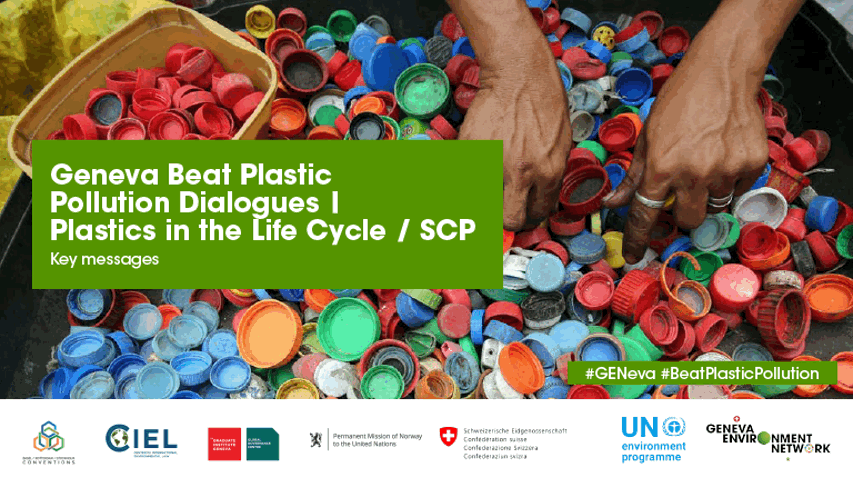Event Virtual
Geneva Beat Plastic Pollution Dialogues | Plastics in the Life Cycle/SCP

The Geneva Beat Plastic Pollution Dialogues aim to facilitate further engagement and discussion among the stakeholders in International Geneva and beyond. In addition, they intend to address the plastic crisis and support coordinated approaches that can lead to more efficient decision making.
About the Dialogues
The world is facing a plastic crisis, the status quo is not an option. Plastic pollution is a serious issue of global concern which requires an urgent and international response involving all relevant actors at different levels. Many initiatives, projects and governance responses and options have been developed to tackle this major environmental problem, but we are still unable to cope with the amount of plastic we generate. In addition, there is a lack of coordination which can better lead to a more effective and efficient response.
Various actors in Geneva are engaged in rethinking the way we manufacture, use, trade and manage plastics. The Geneva Beat Plastic Pollution Dialogues aim to create synergies among these actors, highlighting efforts made by intergovernmental organizations, governments, businesses, the scientific community, civil society and individuals in the hope of informing and fostering stronger cooperation and coordinated actions. The dialogues will also look at what the different stakeholders have achieved at all levels, present the latest research and governance options.
In addition, although the dialogues target stakeholders from all continents, they aim to encourage increased engagement of the Geneva community in the run-up to various global environmental negotiations, such as:
- UNEA-5 (1st and 2nd sessions) in February 2021 and February 2022
- BRS COPs in July 2021
- SAICM ICCM5 in 2022
This first session of dialogues will end in February 2021 to build momentum towards the first session of UNEA-5. It will aim to facilitate further engagement and discussions among stakeholders and actors in International Geneva and across the regions and support coordinated approaches that can lead to more efficient global decision making. It will also intend to provide a platform to further carry the discussion from the recently concluded Ad Hoc Open-Ended Expert Group (AHEG) on Marine Litter and Microplastics towards UNEA-5 part 2 in 2022.
The Plastics in the Life Cycle/SCP session is the seventh dialogue to be organized leading to and making recommendations towards the High-Level Dialogue on Plastic Governance Dialogue on 11 March 2021.
The dialogues are organized in collaboration with the Basel, Rotterdam and Stockholm Conventions Secretariat, the Center for International Environmental Law, the Global Governance Centre at the Graduate Institute, Norway, and Switzerland.
Plastics in the Life Cylce / SCP Session
Through the previous sessions, the Geneva Beat Plastic Dialogues have highlighted some of the impacts (on climate, human health, human rights and the environment) along the life cycle of plastics as well as the need to consider trade, intellectual properties and human rights perspectives to address the plastic crisis.
Many of the early responses developed focused on addressing the end of life stage of plastic. However, in line with the latest UNEA resolutions (e.g. UNEP/EA.4/Res.9) and the conclusions of the Ad Hoc Expert Group, more and more initiatives are broadening the scope of their intervention to the full life cycle of plastic.
The complexity of the plastic crisis and its interlinkage with other environmental crises we are facing (climate, biodiversity loss and pollution) demand that we consider impacts and opportunities at each stage of the full lifecycle to design comprehensive solutions that will effectively limit all impacts of plastic, rather than merely displacing them.
During this session, experts mapped the current life-cycle approaches in place to quantify and address the plastic crisis, detailed international policies and initiatives developed to foster a plastics circular economy, and explored the role and contributions of all stakeholders, along the supply chain, to design and implement comprehensive responses to the plastic crisis.
Other Sessions
- Plastics and Waste | 26 November 2020
- Plastics, Climate and Air Pollution | 10 December 2020
- Plastics and Human Rights | 14 January 2021
- Plastics and Health | 21 January 2021
- Plastics and Standards | 28 January 2021
- Plastics and Trade | 4 February 2021
- High-Level Dialogue on Plastic Governance | 11 March 2021
Speakers

Llorenç MILÀ I CANALS
Head, Life Cycle Initiative, United Nations Environment Programme

Teresa MOREIRA
Head, Competition and Consumer Policies Branch, United Nations Conference on Trade and Development

Hugo SCHALLY
Head of Unit, Multilateral Environmental Cooperation, DG Environment, European Commission

Awidya SANTIKAJAYA
Counsellor, Permanent Mission of Indonesia to the United Nations in Geneva

Kristin HUGHES
Director, Global Plastic Action Partnership, World Economic Forum

Carsten WACHHOLZ
Senior Policy Manager, Institutions, Governments, and Cities, Ellen MacArthur Foundation

David AZOULAY (moderator)
Director, Environmental Health Program, Center for International Environmental Law
Summary
Introduction and Setting the Scene
Introduction to the Session and Setting the Scene | David AZOULAY
Plastics have been the focus of a lot of interest and research recently. Several important conclusions can be drawn from this recent work. The plastic economy is global, and the supply chains are complex. Additionally, negative impacts on the environment, human health, and human rights enjoyment, occur throughout the life cycle of plastics. As the work by the Ad-Hoc Expert Group on Marine Litter and Microplastics also highlighted, it is essential to look at the question of plastic pollution in a life cycle approach that addresses the full supply chain in order to design policy solutions that are comprehensive.
Governance on Plastics and Life Cycle
UNEP Life Cycle Initiative | Llorenc MILA
The Life Cycle Initiative is a multi-stakeholder partnership hosted by the UN Environment Programme since 2002, with public and private funding partners, enabling the global use of credible life cycle knowledge by private and public decision makers. This initiative supports embedding the science of life cycle approaches into policy making and the global agenda for sustainability.
Within this initiative, UNEP works on life cycle assessments (LCA) of single use plastic products (SUPP), as mandated by the fourth UN Environment Assembly (UNEA-4) Resolution on addressing SUPP pollution. SUPP present a significant environmental problem and a global challenge, due to the massive scale at which they are generated, the poor collecting and recycling rates, and the health risks that their disposal create. Therefore, there is a need to develop alternatives to single-use items, and to assess the impacts of these alternatives to ensure we truly reduce the overall impact across the life cycle.
The UNEA-4 Resolution requested UNEP to make available information on action taken by member States to address pollution from SUPP and on the full life cycle environment impacts of SUPP and their alternatives. With the support of the Life Cycle Initiative, UNEP compiled meta-analyses of LCA of various SUPP. In addition to gathering the existing information, consultation and webinars were organized to map what actions have been put in place by member States. The integrative report compiling all this knowledge will launched in the run-up to the first segment of the fifth UNEA (UNEA-5.1). The virtual launch event will take place on 19 February 2021.
LCAs are a standardized way to assess the environmental impacts of products and services across their life cycle, which enables fair comparison between products. Thus, the meta-analysis we conducted allow us to compare SUPP with their alternatives, reveal environmental trade-offs, and inform the development of policy on SUPP. Some of the key findings include:
The clear overarching message is that reusable products are environmentally preferable to single-use ones, regardless of the material, if reused enough times. All materials have an environmental cost; what matters is how we use the products we make out of them. Addressing plastic pollution requires to move beyond disposable products, to change the system in which we are operating, and LCA studies can help to inform this change. The LCA reveals that product design is a critical area of action to reduce environmental impact.
Current policy action to address plastic pollution still focuses mostly on the end-of-life of plastics. We need to adopt a more holistic approach. Comprehensive policy measures are needed at each stage of the life cycle and at different levels. These can include extended producer responsibility (EPR) schemes or deposit-and-return schemes. Action to raise consumer awareness is also important, although it will not be enough as we need the market conditions to be right. On a final methodological note, we are working on methods to include the impacts from marine litter in LCA and to revise the emissions factors for oil and gas production, which will influence the climate change impacts of plastic products.
Consumer Policies Contribution | Teresa MOREIRA
UNCTAD is the focal point for both competition and consumer protection law and policies within the UN system. Indeed, UNCTAD is the custodian of the UN Set of Principles and Rules on Competition and the UN Guidelines for Consumer Protection (UNGCP), which remain the only two internationally agreed instruments on this topic.
The UNGCP includes broad and cross-cutting recommendations to facilitate production and distribution patterns responsive to the needs and desires of consumers, and to promote sustainable consumption. Consumers legitimate needs – also called consumers rights – include access to adequate information, education on the environmental, social and economic consequences of consumption choices, and the promotion of sustainable consumption patterns. Recent recommendations under the UNGCP also address the role of governments and the relevance of adopting legal and institutional frameworks. The last revision of the UNGCP also includes a chapter addressed at the private sector on good business practices.
Education and information programmes are essential for empowering consumers, although they need to be combined with consumer protection frameworks. These programmes can be developed by governments, or consumer organizations and other relevant stakeholders. In that area, UNCTAD is part of the One Planet Network with UNEP, Consumers International and other stakeholders. Information is both a right and an obligation for consumers. Special attention needs to be granted to vulnerable and disadvantaged consumers.
The UNGCP includes a chapter on sustainable consumption which emphasizes shared responsibility and the need for partnership with stakeholders, the relevance of mixed instruments and tool, the role of methodologies and data (such as LCAs), the importance of encouraging businesses in the right direction and the leadership of governments through sustainable practices in procurement. In addition, the Good Business Practices guidelines recommends encouraging high levels of ethical conduct for traders and provides, promoting private sector standards, ensuring business compliance with consumer protection law, and fostering self-regulation as a complement to regulatory measures.
Sustainable Development Goal 12 – Sustainable Consumption and Production – clearly states the importance of reducing waste generation through the reduction, reuse, recycling of plastics. A shift toward a more sustainable lifestyle requires both consumer policy measures and economy policy measures. The World Consumer Protection Map provides an interactive overview of what member States are doing in the field of legal consumer protection.
UNCTAD has produced some data on plastics, both globally and on the specifically case of small island developing states. Some countries are already taking measures to phase out single-use plastics and encourage recycling. These actions follow the famous slogan “Reduce, Reuse, Recycle”. A recent UNEP’s report focused on South-East Asia revealed that consumers are aware and interested in obtaining information on plastics and opting for alternatives. Of course, the substitutes and alternatives need to be provided on the market.
To conclude, multi-stakeholder dialogue and coordination among actors is essential to promote sustainable consumption and production in the area of plastics. Consumers can play a very important role but need an encourage frameworks. On a final note, while competition law and policy, which is also part of UNCTAD’s work, is often seen as a hurdle for green innovation, recent discussions within the EU are looking at how social and environmental impacts can be integrated. From this point of view, competition law and policy can actually encourage sustainability.
Global Plastic Action Partnership | Kristin HUGHES
The Global Plastic Action Partnership (GPAP) is a multi-stakeholder platform at the World Economic Forum that aims to shape a more sustainable and inclusive world by eradicating of plastic pollution through the engagement of private and public players. GPAP was created in 2018 by a group of public, private and civil society leaders under the belief that we need to come together to create real change. A convergence of players came together at the World Economic Forum to figure out how we can address plastic waste pollution. Two years later, we are present in three partner countries – Indonesia, Ghana and Vietnam – and we are beginning to see change on the ground thanks to these private-public unique conversations. We just announced a fourth partnership with Nigeria, which will come to shape soon.
These conversations also including civil society, academia, international organizations and all contributors and allies that are essential to develop realistic solutions to end plastic pollution and develop a circular economy for plastics. The role of governments is to set the targets, lead he programmes for concrete change, and create incentives to shape a positive environment for investing in steps aligned with reducing plastic pollution. The role of the private sector is to translate these into greener supply chains. These can involve change in packaging design or business models to foster reuse and refill. At the level of the consumers, the adoption of the Reduce-Reuse-Recyle principles is essential. Finally, investors are also at the forefront to inject funding into the innovations that bring circular economy to life.
As part of the GPAP, we also have National Plastic Action Partnerships (NPAP) to work directly with governments at the national level. We bring together decision-makers, experts, and changemakers to work on a joint approach that is locally owned, locally driven, and that puts the livelihood of people and communities upfront. Of course, there is no one-size-fits-all type of solutions, but if you bring the right people and resources to the table, these solutions can be realized. These efforts can bring countries and communities to rapidly reduce their mismanaged plastic waste and build the path to a sustainable circular economy for plastics.
GPAP is built on three pillars: (1) convene communities and curate conversations, (2) analyse the situation, generate new insights and action roadmaps, and (3) turn commitments into concrete action and catalyse strategic financing. This approach focuses on collaboration for concrete and measurable progress in the fight against plastic pollution.
Plastics are undeniably essential: they are versatile are affordable, and they are the bedrock of medical equipment and protective gear, keeping us safe during the pandemic. However, there is a worrying trend of the increasing demand for disposable products. We need to figure out how to move beyond that. The future of recycling and sustainable waste management is critical to drive circular economy. Government support is needed keep the industry moving forward, and the private sector needs to come to life to promote circular economy throughout the value chain. Working with civil society and international organizations, together we can support this desire to create a circular economy for plastics.
The GPAP welcomes your engagement and collaboration, as we believe in the power of public-private to address plastic pollution. Through collaboration, the final outcome will be greater than the sum of our parts.
A New Plastics Economy | Carsten WACHHOLZ
The Ellen MacArthur Foundation is a charity based in the UK, whose mission is to promote circular economy. We work with businesses, policymakers, academia, and institutions around the world to mobilize system solutions at scale. Since 2016, the New Plastic Economy initiative has brought together key stakeholders to rethink and redesign the future of plastics.
Based on a comprehensive model of the plastic economy published in 2020, it is clear by now that we cannot recycle or dispose our way out of the problem, nor would simply reducing our plastic usage do the trick. We need a comprehensive circular economy. First, we need to eliminate the plastics that we do not need. Secondly, we need to circulate the plastics that we do need by funding collection, sorting and recycling. However, even if we deploy all the solutions known today at maximum speed and scale, modelling shows that there would still be more than 150 million tons of plastic waste being incinerated, landfilled or mismanaged every year by 2040. Therefore, we must innovate at the same time at unprecedented speed and scale.
The good news is that there is an unprecedented level of alignment in the industry on the way forward. The Plastic Economy Global Commitment and the Plastics Pact Network already unite more than 1’000 organizations behind a common vision. These networks are working with stakeholders towards concrete targets for 2025. Via business signatories, the Global Commitment reaches out to more than 20% of the global plastic packaging market, while the Plastic Pact Network covers twenty countries representing 30% of GDP worldwide. Currently, the progress within the Global Commitment is mainly driven by packaging producers and retailers. Other parts of the plastics value chain are still underrepresented.
Our 2020 Progress Report revealed the increasing efforts to phase out the most problematic categories and to incorporate recycled content in some types of plastic packaging. However, much more needs to be done. We call on businesses to adopt solutions that go beyond recycling, including ambitions reduction targets and reuse business models. Businesses also need to rethink products and delivery systems to eliminate the need for packaging altogether, as outlined in our Upstream Innovation Guide. We also need to take bold action on non-recyclable packaging, for instance with a well-funded research, development and research agenda for new delivery models and materials.
The 2020 Progress Report also points out that additional efforts from policy makers are needed. There is a need for mechanisms to deliver dedicated funding for collection, sorting and recycling, where the industry pays its fair share for instance through extended producer responsibility schemes (EPR). We also need to work toward a more binding and consistent policy framework at the international level with the goal to stop plastic leaching into the environment.
The relevant policies for a circular transition are interconnected. The Foundation has identified five universal and overarching economy and policy goals.
- Stimulate the emergence of circular design and business models
- Create a system for resources management to ensure that the values of goods and materials are preserved
- Adapt the physical and legislative framework to make circular economy work
- Increase public and private finance capabilities to scale up circular economy
- Mainstream circular economy principles into existing and new policies
A new UN treaty on plastic pollution could help us overcome the patchwork of fragmented solutions and to avoid that individual measures remain isolated in a wider unchanged economic system that is still based on a linear take-make-waste approach. Governments should address circular economy for plastics through both up- and downstream measures (goals 1-2), while creating the wider conditions that are needed for scale (goals 3-4), all underpinned by a multi-stakeholder engagement approach (goal 5).
Indonesia Lifecycle Approach to Plastics | Awidya SANTIKAJAYA
Plastic pollution has become one of the most pressing environmental issues. However, for many developing countries, including Indonesia, discussing plastics is bring conflicting ideas between environmental protection and economic interest. With its large population living in thousands of islands, Indonesia faces great difficulties in effectively preventing plastic waste from entering the oceans.
On the other hand, the plastic industry is becoming increasingly important in Indonesia. There are more than 1’500 plastic producing companies that employ more than 35’000 people. While plastic clearly harms the environment, it delivers many economic benefits to some parts of our society. Thus, policymakers face the daunting challenge to identify policy solutions that could lead to win-win scenarios.
When the Indonesian government intended to introduce a nation-wide ban on single-use plastics in 2017, the initiative faced vast resistance emerged from the plastic industry. As a result, the policy failed to be implemented and is currently only effective in two provinces out of thirty-four. Similarly, the Indonesian Ministry of Finance submitted a proposal to impose a tax on plastic bottles, but it has not yet been approved by the parliament and it intensively rejected by the private sector.
The narrow approaches to reduce plastic pollution used until now are insufficient. Plastics need to be addressed comprehensively through multi-stakeholder collaboration. Governments need to be able to create incentives for consumers and the private sector to adopt green products. In that context, Indonesia has adopted a holistic approach to plastic pollution and targets for 2025: reduce marine plastic debris by 70%, reduce waste by 30%, and increase the quantity of waste properly handled by 70%.
One example of action taken under this holistic approach is the implementation of extended producer responsibility (EPR). In 2019, Indonesia released an EPR roadmap aiming to give producers an incentive to incorporate environmental considerations into the design of their products. With this approach, Indonesia can slowly move toward a circular economy. In that context, plastic should be optimized in its entire life cycle.
Additionally, Indonesia carries out pilot projects aimed at maximizing the value of plastic waste. Two waste-to-energy are already in operation and an additional ten will be built across Indonesia by 2022. In total, these will generate around 234 MW from around 16’000 tons of waste per day. Indonesia also built roads using a mixture of asphalt and recycled plastic asphalt in seven cities and plans to expand this initiative to sixteen additional cities by 2023. Indonesia also built its first plant to produce fuel out of waste, including non-recyclable plastic waste. This plan converts 2 tons of domestic waste into refuse-derived fuel which can substitute coal in the production of cement. These projects are still in scale and need further investment, financial support, research, and expertise.
Indonesia is lucky to get support from the World Economic Forum through the National Plastic Action Partnership (NPAP). This platform allows for collaboration between various stakeholders to develop solutions. The collaboration between governments and the private sector is essential to increase our collective capacity to address plastic pollution. A global shift to more sustainable growth will be unsuccessful without meaningful collaboration and partnerships to support developing countries in pursuing a circular economy.
EU Plastics Strategy | Hugo SCHALLY
The European Green Deal, as a growth and prosperity strategy for the EU, has survived all the difficulties linked with the pandemic and remains very high on the political agenda. The Circular Economy Action Plan, first developed in 2015 and now incorporated in the EU Green Deal, is a key piece of the EU strategy.
The Circular Economy Action Plan contains 35 headline actions along the entire life cycle of products, which are highly relevant to the issue of plastics. To make sustainable products the norms in the EU, the EU will roll out a new Sustainable Products Initiative legislation later this year. Empowering consumers and public buyers is also important with the new consumers agenda in the EU. The EU will also focus on key product value chains that are relevant to the plastics economy and ensure less waste with more value. It is also important to make circularity work for people, regions and cities, to ensure that circular economy contributes to new business models and is mainstreamed. Finally, recognized the limits of national and regional action, the EU also wishes to lead global efforts on circular economy.
The EU is preparing and implementing rules to address design, use, distribution, and treatment at the end-of-life of plastic products. This includes mandatory requirements for recycled content and waste reduction measures, measures to address the presence of microplastics in the environment, a policy framework on bio-based and biodegradable plastics, and the implementation of the Single-Use Plastic Products Directive which will be effective this summer.
With the Single-Use Plastic Products Direction, we have made a start with a minimum recycled content requirement in certain products and this will be applied to a wider range of products through the Sustainable Products Initiative. The goal is to have 10 million tons of recycled plastics in new products on the EU market by 2025, a tripling of the current numbers.
Microplastics is a specific issue that also relevant for the design, use, and disposal of plastic products. The EU is working toward a ban of microplastics intentionally used in cosmetics, detergents, and paints by 2021, and aims to improve the production chains of pellets. Regarding microplastics created by use, the EU will address tires and textiles as the main sources through regulation and standards. Efforts to improve water treatment is always underway.
Bio-based and biodegradable plastics raise important questions as to whether they are inherently better for the environment than regular plastics. We need to look at the impacts of a larger move to bio-based plastics, in terms of available feedstock, and at the uses of these biodegradable plastics, as they do not offer a “license to litter”. We also need to conduct economic analyses of compostable plastics as alternatives to regular plastics. All the work is ongoing at the EU and will be rolled out this year.
All these elements offer a snapshot of the policy and initiatives happening within the EU. Considerable efforts are also led by other countries, international organizations, voluntary initiatives, and various stakeholders, inspired by an emerging science-policy consensus that plastic pollution needs to be urgently addressed. However, as plastic value chains are global, we need a global architecture to deal with that problem. There is a need to promote circular economy bilaterally, regionally and multilaterally, through the development of international cooperation programmes.
In that context, we will launch the Global Alliance on Circular Economy and Resource Efficiency (GACERE) during the first segment of the UN Environment Assembly (UNEA-5.1). Following the resolution from UNEA-4, UNEP has also been working on identifying the safe operating space for natural resource use within planetary boundaries and this research will be extremely useful in working toward UNEA-5. At UNEA-5-2, we will also need to reflect on a potential international agreement on natural resource management.
A number of principles can support a global agreement on plastics. First, the problem is transboundary in scale and nature, and therefore no country can do it alone. Secondly, governance gaps exist along the full life cycle but are most prominent in the upstream part. Therefore, we need to build on existing instruments to avoid duplicating efforts. In many cases, the uncertainty of national responses comes from the absence of global standards and a common vision. Therefore, a final key element is that the agreement should not restrict governments but support them and enable them to do what is right for them.
From our perspective, we hope that we can build on the outcomes of the Ah-Hoc Open-Ended Expert Group on Marine Litter and Microplastics, as we know have sufficient information to urgently take action at the global level. We hope that a decision will be taken at UNEA-5.2 so that we can bring everybody to the table to design an architecture to help us beat plastic pollution.
Q&A
How realistic is a global harmonized legally binding EPR scheme, and to what extent could that be a solution?
Kristin Hughes: EPR is quite regularly proposed as a solution. It can definitely support the system, so long as it is utilized specifically to address plastic pollution. Many businesses are supporting EPR schemes, as they have seen the benefits, for example in the e-waste sector. But it can only work if the EPR is not just another tax, but is designed to properly support the circular economy through investment in collecting, sorting, recycling, etc.
Hugo Schally: The value of a global architecture would be in establishing common principles and in facilitating the transmission of information about products and their material and chemical characteristics along the value chain. This exchange would allow to set up national systems to deal with these products. A global EPR system is probably unrealistic, but we can ensure that the value chain is well integrated into a common understanding of EPR to facilitate the appropriate action at the national and regional level.
Carsten Wachholz: EPR is a key part of the solution and it needs to be integrated with other policy measures upstream. However, it does not make sense to limit EPR to plastics: we would have to set up a broader system which cover materials relevant for the waste management system. At the global level, it would be useful to work on a definition and classification system of the different materials which could be captured through an EPR system, so that national governments can set up an appropriate system. To develop a system that works in practice, a multi-stakeholder approach is warranted to tailor the general principles to the economic and geographical conditions of a specific country.
Llorenç Mila: Another key element is that the common principles should be shared. EPR can be very successful, but they have to be well designed and well implemented. For instance, elements of ecomodulation on the fees are important to send a clear signal to the designers of products entering the market. It would be difficult to make a common system for absolutely every country, but EPR can certainly be a good part of the solution when designed adequately. At the global level, information sharing is crucial, and it could be part of a globalized framework for EPR schemes.
Teresa Moreira: EPR schemes are an ambitious and appropriate manner to deal with a global issue, although it may be a bit unrealistic. Information sharing is essential, as previously mentioned, and increasing these information flows at the regional level can bring significant benefits, especially as developing countries are facing their own realities.
Awidya Santikajaya: Indonesia implemented an EPR roadmap last year. In our perspective, it is too early for a harmonized global legally binding EPR scheme. At this stage, we should start by sharing information and experiences on how EPR is enforced, what are the necessary institutional capacities, etc. Overall harmonizing EPR is a good idea, but for Indonesia it is still too early, and this is probably the same for many countries.
Closing
Video
In addition to the live WebEx and Facebook transmissions, the video is available on this webpage.
Documents
- Invitation
- Presentations made during the event
- Outcomes of the Plastics in the Life Cycle / SCP session

Links
The update on Plastics and the Environment provides relevant information and the most recent research, data and articles from the various organizations in international Geneva and other institutions around the world.
- Single-Use Plastic Products (SUPP) and their alternatives: Recommendations from Life Cycle Assessments | Life Cycle Initiative | UNEP
- European strategy for plastics | EU Commission
- New Plastics Economy | Ellen MacArthur Foundation
- Information on implementation of resolution 4/9 on addressing single-use plastic products pollution | UNEP | 23 December 2020
- Plastic’s Toxic Additives and the Circular Economy | The Stockholm Regional Center (Barcelona), BRS MEAs, UNEP MAP & IPEN | 25 September 2020
- We can stop plastic pollution at the design stage – here’s how | World Economic Forum | January 2020
- Addressing Marine Plastics. A Roadmap to a Circular Economy | UNEP | 2019
